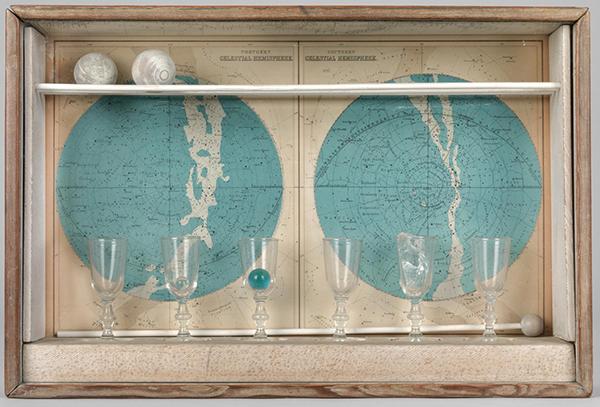The Royal Academy presents Joseph Cornell: Wanderlust, a survey of the artist’s complex and eclectic oeuvre exploring around 80 of Cornell’s intricate box constructions, assemblages, collages and films. The re-appraisal of the artist’s work comes some 35 years after the last major solo exhibition of Cornell in Europe, originating at the Museum of Modern Art, New York, in 1980, and travelling to the Whitechapel Gallery in the UK.
Cornell was an explorer – a collector – an enigmatic archivist of an artist. The artist sought out meaning in the cataloging of the mysteries that surrounded him. Cornell was a diarist, and recorded that world with the intensity of da Vinci; even calling his dossiers of cataloging his ‘explorations’. The artist would posit these explorations as relationships, either conceptual, or poetical, juxtaposing collected objects, measurements, and images, birds eggs, thimbles, models, all enigmatically staged to present a poetry of wonderment. In fact Cornell called his vitrines ‘poetical theatres’ – which they often are in a quite traditional sense – with other assemblages highlighting the conceptuality of materials, the poetry and the perceived child-like strangeness of the world, and the artist’s observations as if from the eyes of an innocent – with a purity of wonder.
The artist’s oeuvre blurs traditional definitions and genres via idiosyncratic motifs, Cornell is the subjective scientist, exploring with a child-like lust for understanding, building dioramas, and ‘kits’ – creating his clockwork universes as poetical equations designed as at once highly personal objects and a means to an artistic and intellectual end. The artist’s works could be seen as assemblages of material from places that he would never visit: as except for the three and a half years that Cornell spent at Phillips Academy in Andover, he lived for most of his life in a small, wooden-frame house on Utopia Parkway in a working-class area of Flushing, New York, along with his mother and his brother Robert, whose cerebral palsy prevented the artist from travelling.
 Joseph Cornell, Habitat Group for a Shooting Gallery, 1943. Photograph: Joseph and Robert Cornell Memorial Foundation/VAGA, NY/DACS, London 2015
Joseph Cornell, Habitat Group for a Shooting Gallery, 1943. Photograph: Joseph and Robert Cornell Memorial Foundation/VAGA, NY/DACS, London 2015
Cornell’s immediate environment may have been physically limiting for the artist – but his fascinations drew on his desires and we soon had creations such as Cornell’s ‘Soap Bubble Set’, the ‘Celestial Navigation Series’ and the artist’s particularly telling ‘Hotel’ series’. These works would subvert microcosm and macrocosm; where, with the ‘Hotel series’ Cornell would collect old advertisements for European hotels evoking the romance of travel that he so longed for, then subverting, or expanding the idea to the nebulous topography of the universe – referencing Andromeda and the mythologies surrounding the constellations – in this instance relating them back to the sea where sailors would use the heavens as a navigational aid.
The artist built emotional equations from physical assemblages; subjective homages to his interests and desires, overflowing with his fascinations. Cornell also appropriated practices as well as objects, taking the art of collage pioneered by European modernists and giving it his trademark romantic and innocent perspective, in fact there is something of particular note in the artist’s work – or should I say lacking – that is any particular interest in the sexual or carnal is transmuted to the romantic innocence of the dreamer; Cornell falls in love with ballerinas and with the very nature of the ‘romantic’ – the perspective of the wide-eyed child is never once transgressed. But instead the wonderment of the victorian curiosity is built and re-built via Cornell’s fascination with ‘Natural Philosophy’ a term garnered from the period, conjuring an era lacking any distinction between artist and scientist – and quite rightly.
As German artist Joseph Beuys built his vitrines in pursuit of the shamanistic enigma; Cornell did so out of the need to explore the universal enigma; echoing the spirals of divine order. The viewer bumps into the Fibonacci sequence, the golden spiral leads us away from the artist’s toys towards the gentle insinuation of a deeper desire to merge the mathematical order of the universe with the divine and with poetry. The true thinking of a renaissance artist.
Cornell’s glass-fronted shadow boxes were indeed toys, games of study for the artist at play in the world, leading to Robert Rauschenberg’s assemblages of everyday items. There’s nothing new in a Hirstian vitrine, it’s all been played with before – and with considerably more magic.
Words: Paul Black photos courtesy of the gallery – © Artlyst 2015 all rights reserved
Joseph Cornell: Wanderlust – The Royal Academy Of Arts – until 27 September 2015

